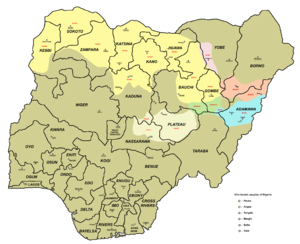- Margi language
-
Margi Spoken in Nigeria Region Borno State, Adamawa State Native speakers 160,000 (2006) Language family Afro-Asiatic- Chadic
- Biu–Mandara
- A
- Bura–Marghi
- Marghi
- Margi
- Marghi
- Bura–Marghi
- A
- Biu–Mandara
Language codes ISO 639-3 mrt  Ethnic territories of the Marghi-speaking people in Nigeria (organge)
Ethnic territories of the Marghi-speaking people in Nigeria (organge)This page contains IPA phonetic symbols in Unicode. Without proper rendering support, you may see question marks, boxes, or other symbols instead of Unicode characters. Margi, also known as Marghi and Marghi Central, is a Chadic language spoken in Nigeria. It is perhaps the best described of the Biu–Mandara branch of that family. Marghi South and Patai are closely related, and sometimes considered dialects of Margi.[1]
Phonology
Margi is famous for having a vertical vowel system, with only two vowels, /ɨ/ and /a/, in native vocabulary. (Loan words also distinguish /ɛ/ and /o/.) There are two tones, high and low, with some syllables unmarked for tone. Margi also has a large consonant inventory, with a number of labialized consonants and unusual things such as a labiodental flap. Hoffmann (1963) describes 84 consonantal phonemes, an enormous number compared to that of most languages. However, Hoffmann's list of consonants includes all onsets in the language, many of which other researchers have since analyzed as sequences, such as /pt/ and /bz/.[2] What remains are 66 consonants if labialization is counted separately, or 54 if it is interpreted as a /Cw/ sequence.
Consonants Labial Dental Alveolar Lateral Post-
alveolarPalatal Velar Labio-
velarGlottal Nasal m mʷ n ɲ ŋ ŋʷ Glottalized ɓ̰ ɓ̰ʷ ɗ̰ j̰ w̰ Prenazalized mp nt ntʷ nts ntsʷ ntʃ ɲc ŋk ŋkʷ mb mbʷ nd ndz ndʒ ɲɟ ŋɡ ŋɡʷ Oral
occlusivep pʷ t tʷ ts tʃ c k kʷ ʔ b bʷ d dz dʒ ɟ ɡ ɡʷ Fricative f fʷ s sʷ ɬ ɬʷ ʃ [ç] x ʍ v vʷ z ɮ ʒ [ʝ] ɣ Approximant l j w Vibrant ⱱ r [ç] and [ʝ] are palatalized allophones of /x/ and /ɣ/, the latter of which is closer to an approximant [ɰ].[3] The closely related language Bura is similar but has a palatalized lateral series as well. /ⱱ/ is used in mimesis rather than in lexical vocabulary. The glottalized consonants /ɓ̰ ɓ̰ʷ ɗ̰/ have been described as either creaky voiced or implosive; according to Maddieson, they are evidently both, as in Hausa.[4]
The sequences which Hoffmann included in his consonant inventory are all labial–coronal:
- ps [fs], pɬ, pç [fç], pt, pts, ptʃ, mpt, mpts, mptʃ, bz [vz], bɮ, (bʝ [vʝ]), bd, bdz, bdʒ, mbd, mbdz, mbdʒ, ɓ̰ɗ̰, mn[5]
Notes
- ^ Raymond G. Gordon, Jr, ed. 2005. Ethnologue: Languages of the World. 15th edition. Dallas: Summer Institute of Linguistics.[1]
- ^ Ladefoged, Peter; Maddieson, Ian (1996). The Sounds of the World's Languages. Oxford: Blackwell. p. 344. ISBN 0-631-19814-8. There are very few true labial–coronal consonants in the world.
- ^ Ladefoged, Peter; Maddieson, Ian (1996). The Sounds of the World's Languages. Oxford: Blackwell. p. 165. ISBN 0-631-19814-8.
- ^ Ladefoged, Peter; Maddieson, Ian (1996). The Sounds of the World's Languages. Oxford: Blackwell. p. 85. ISBN 0-631-19814-8.
- ^ There may be a few others, such as pɬ~mɬ, mʃ~mtʃ.
References
- Hoffmann, C. 1963. A Grammar of the Margi Language. Oxford University Press for International African Institute, London.
- Maddieson, I. 1987. "The Margi vowel system and labiocoronals." Studies in African Linguistics, vol. 18, No. 3, Dec. 1987.
Categories:- Biu-Mandara languages
- Languages of Nigeria
- Biu-Mandara language stubs
- Nigeria stubs
- Chadic
Wikimedia Foundation. 2010.
